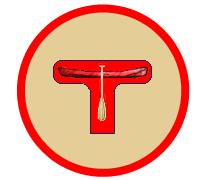

A good defence against bugs can make the difference between having a good time on a camping trip and having a miserable time. There are many people who will never again go on a camping trip because of one bad, bug-infested camping trip. Depending on the location and time of the year the mosquitoes or black flies (or both) can be so numerous that they literally chase one from the woods (and onto the lake, into a tent, or for some - the ones who will likely never come back - into a hotel room).
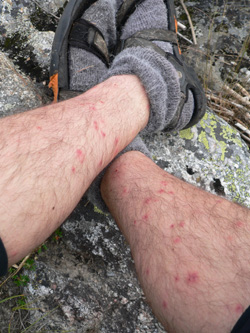 Black Fly Bites
Black Fly Bites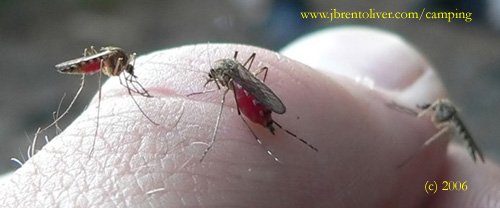 Mosquitoes
MosquitoesFortunately, there are plenty of methods of protection that can be employed against the onslaught to minimize (but never eliminate) the discomfort of "bug season".
DEET (diethyl toluamide) is the gold standard in protection against black flies and mosquitos. It has been in use for over 40 years and
is considered safe and effective. However, there are two issues with the use of DEET. One is the reaction DEET is puported to have on
some individuals. Some people have a sensitivity to DEET that manifests itself in the form of headaches and in more severe cases, red,
burning skin. The second issue is the fact that DEET can be damaging to synthetic materials. Unfortunately much of the clothing and
equipment used by the camping community is synthetic and is subject to discolouration or more severe damage when DEET is applied to
it either accidently or intentionally.
Recent regulations in Canada require that DEET products sold cannot contain a concentration of no more than 30% DEET (whereas
in the United States formulations of 98%+ DEET are still available). Fortunately, a 30% concentration of DEET is just as effective
as a 100% concentration, it just doesn't last as long and requires more frequent application. Since most people aren't exposed to
mosquitos for long periods of time the government regulation helps to limit exposure of DEET to the average person.
I personally do not use products containing DEET and have not as far back as I can remember. There is something about intentionally
applying a chemical that is known to "eat" plastics directly to the skin that just doesn't sit well with me. However, other than
the aforementioned sensitivities that some people have, DEET has been used for a long time and is extremely well tested and can
therefore be considered safe for most people when used in moderation. That said, I still won't use it! Well, I should clarify. I choose
not to use it while camping and canoeing in Canada and the northern U.S. where mosquitos and black flies are mainly just a
nuisance. However, when travelling to locations where malaria and other tropical diseases are tranferred by mosquitos, DEET is
a wise choice. The benefits in such a situation far out-weigh the risks of the chemical itself.
The Canada Communicable Disease Report (CCDR) from the Public Health Agency of Canada states*:
* Source: Public Health Agency of Canada Travel Health Advisory, March 3, 2006
In 2006, a relatively new and mostly unknown chemical started to appear in the U.S. market - it showed promise as an effective DEET alternative. Picaridin is advertised as being odourless, colourless, non-reactive to clothing or plastics, non-toxic, non-irritating, and non-sticky. Based on personal experience
and from other user reviews the claim
seems to be accurate.
A study by
the Austrialian Defence Force in 2002 found that "in both nighttime and daytime tests, 19.2% picaridin provided protection better
than or similar to formulations of deet". The report also states that "Significantly more soldiers reported mild discomfort and irritation
with the use of ADF deet compared with 19.2% picaridin" and that "94% (141/150 responses) preferring the aerosol pump action
spray [containing 19.2% picaridin] over the [35% deet] gel".
The Centers for Disease Control and Prevention (CDC) in the United States also recommends mosquito
repellents with Picaridin. It found that products containing Picaridin and Deet -- both ingredients which are registered with the U.S.
Environmental Protection Agency (EPA) -- have demonstrated a higher degree of efficacy in the peer-reviewed, scientific
literature than other chemicals registered with the EPA. More information is available at the CDC web page
titled What You Need to Know about Mosquito Repellent.
Even more information and links are available at outdoors.org
In Australia, Autan Repel (Bayer), with a concentration
of 9.3% Picaridin, became available in the year 2000 and, more recently, Cutter Advanced (Spectrum)
containing 7% Picaridin became available in the United States. Unfortunately, as of 2006, a Picaridin-based repellant is still not available in Canada (and not yet seen as of Summer 2017). However, those living close to the Canada-US border can easily get Cutter Advanced at a U.S. retailer such as Wal-Mart or K-Mart. Other brands of picaridin-based repellants
available from U.S. retailers (recently seen available at REI) are Natrapel and Sawyer
Citronella, Lemongrass and Cedarwood Oils
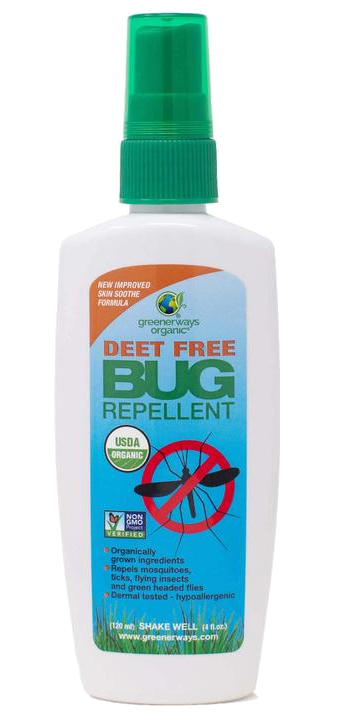
A combination of natural oils that is very effective (based on personal experience) is:
Oil of lemon eucalyptus is another alternative to DEET-based products that is favoured by some because of the perceived safety of its "natural ingredient". A plant-based repellent, oil of lemon eucalyptus is chemically identified by p-menthane 3,8-diol (PMD). This chemical, like DEET and picaridin, is registered with the U.S. Environmental Protection Agency (EPA) and therefore is subject to additional testing for efficacy and potential effects on humans and the environment. The CDC reports that in at least two scientific publications, oil of lemon eucalyptus was found to provide protection similar to products containing low concentrations of DEET (against mosquitos found in the U.S.)
Tests in 2005 by Consumer Reports (and reported in their August 2005 publication) also found mosquito repellent with oil of lemon eucalyptus to be effective. They described their test results as "impressive". Specifically, they tested a product called "REPEL Lemon Eucalyptus Insect Repellent" which was the more concentrated of the two leading eucalyptus-based repellents. Consumer Reports found that Repel didn't damage plastics like DEET but that it did stain leather (as does DEET).
At this time I am not aware of any specific brands of eucalyptus-based insect repellent products being sold in Canada although I suspect that you can find some. Choose brands that have the highest concentrations of eucalyptus oil for the best protection.
Non-Spray Personal Protection Devices
May 2012: A relatively new class of personal protection devices have been on the market for a few years (at least) and are gaining in popularity. The two popular brands are SC Johnson's "OFF! clip-on", and ThermaCELL Mosquito Repellent. Both products promise hours of odourless personal protection against mosquitos when the device is clipped on to your belt or clothing and the device is on.
The OFF! clip-on device operates with batteries that drive a small fan. The fan distributes the chemical repellant (Metofluthrin 31.2%) into your personal space to keep mosquitos at bay. Each refill disk claims to last up to 11 hours. The packaging suggests that a pair of AAA batteries will last approximately 12 hours. The packaging also provides this precaution: "Avoid breathing vapor". What?!?! I'm not sure if I can hold my breath for hours on end but in the interest of providing a first-hand review I guess I'll have to try.
The results of my first use of this product were disappointing. I sat in a mosquito infected area for a number of minutes to attract some mosquitos before turning the OFF! device on. I continued to sit in the same spot for almost ten minutes waiting for a clear indication that I was being protected. I never got that indication. I continued to be bitten. I even tried moving the device closer to the mosquitos in the process of drawing blood from me. They really didn't seem to mind as far as I could tell. As I sat - and continued to have mosquitos land on my arm - I wondered about the effectiveness should I actually be moving about. My guess is that the effectiveness, or lack of, would be further reduced as one walks about, effectively moving away from the cloud of repellant. Hmm, not so sure this is a practical solution for active campers.
The ThermaCELL appliance is similar in claims but uses the chemical allethrin, and a butane cartridge rather than batteries. It generally costs more that the "OFF! clip-on" but claims to be more effective (98% effective claimed on their website) against mosquitos, black flies, and noseeums.
The U.S. Center for Disease Control (CDC) FAQ on Insect Repellent Use and Safety says:
CDC recommends using products that have been shown to work in scientific trials and that contain active ingredients which have been registered with the US Environmental Protection Agency (EPA) for use as insect repellents on skin or clothing. When EPA registers a repellent, they evaluate the product for efficacy and potential effects on human beings and the environment. EPA registration means that EPA does not expect a product, when used according to the instructions on the label, to cause unreasonable adverse effects to human health or the environment.
Of the active ingredients registered with the EPA, CDC believes that two have demonstrated a higher degree of efficacy in the peer-reviewed, scientific literature (See Publications page.). Products containing these active ingredients typically provide longer-lasting protection than others:
Oil of lemon eucalyptus [active ingredient: p-menthane 3,8-diol (PMD)], a plant- based repellent, is also registered with EPA. In two recent scientific publications, when oil of lemon eucalyptus was tested against mosquitoes found in the US it provided protection similar to repellents with low concentrations of DEET.
Various non-chemical repellants are also available. At best some of these products may be effective for short periods of time and at worst they may have no effect. Manufacturers claim that natural products such as citronella, lavendar oil, lemon eucalyptus oil and even soybean oil are effective but most have limited effectiveness and don't last nearly as long as products containing over 10% DEET.
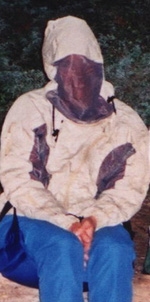
Perhaps the best non-chemical method of protection against mosquitos and black flies is to wear a bug jacket. Bug pants and even bug gloves are also available. Most campers find that wearing long pants, a long sleeve shirt, socks and a bug jacket (or bug hat) is sufficient to keep your sanity during bug season. Unfortunately, bug jackets - despite being made mainly of mesh - hold in your body heat and can be uncomfortable during warm weather.
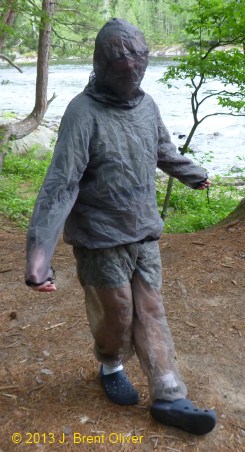
Black flies are adept at finding their way under your clothing - including bug jackets. To help thwart their efforts make sure that you tuck your pants into your socks and your shirt into your pants.
Black flies prefer to fly to the highest point around. That is why they tend to gather on the ceiling of your tent rather than swarm you when you are in your tent. They will bite though during the night so it is best to kill them before falling to sleep. Make sure you bring some Benadryl with you on a camping trip. A bite to the eye lid while you sleep can cause you to wake with a swelling bad enough that you can't see out of that eye. This situation can be a bit frightening if you have never experienced it before but a Benadryl tablet or two will quickly reduce the swelling and restore your sight.
Now that you know that black flies like high places, here's a trick to try the next time you are camping in a black fly infested campsite: